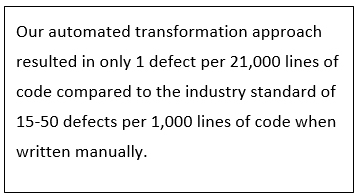Across the federal government, agencies face steep challenges in modernizing legacy applications such as data-rich, business process-intensive mainframe systems to modern architectures. One U.S. Department of Defense (DOD) program turned to CGI Federal to help modernize its mission-critical supply chain and equipment support system used by 18,000 personnel at 260 global locations. Facing increasing operating costs for legacy components, the program recognized the need to update its complex supply chain system to an open platform while maintaining all functionality. The system, considered an ACAT III Major Defense Acquisition Program, serves as the accountable data system for over $30 billion in inventory critical to military operations.
The DOD already had modernized some components of the system; however, one major component—more than a half-century old and containing retail-level business logic—still ran on the mainframe. Past attempts to modernize this component, responsible for approximately 500,000 transactions per day, had failed. The size and complexity of the task had proven too much for previous modernization attempts.
Overcoming modernization obstacles
After more than 50 years of operations, maintenance and extension, the component’s code was not well-documented. Current subject matter experts knew only a fraction of the system’s complex business rules. Finding COBOL programmers proved equally challenging.
Seeking new approaches to modernize the 1.3 million lines of COBOL source lines of code and 1.2 million lines of COBOL code—while maintaining the current business rules—the DOD looked to CGI for help.
Setting aside strategies such as a manual rewrite and re-architecture due to risk and cost, the program chose a COBOL to Java code automated refactoring solution. Using a low-risk incremental approach to deliver on modernization requirements, the CGI-led team applied effective tooling for rapid high-quality software delivery.
Preserving business rules through a three-phased modernization approach
To meet the program’s requirements within cost, schedule and risk constraints, CGI recommended a three-phased approach to modernization. In phase one, the team used advanced tooling TSRI JANUS Studio© to automatically refactor COBOL to Java, converting 1,260,679 lines of COBOL code and 10,078 lines of C code to Java. Rather than simply transliterating source COBOL code to target Java code, the tool executes a mature automated conversion into what we termed an intermediate translation language. This allowed subject matter experts to then employ an iterative process of applying rules and tuning to output the transformed code into the target Java language. At the same time, the team transformed the COBOL data management code to SQL.
For phase two, CGI refined the new Java code, which contained COBOL paradigm design remnants (often called COBOL overtones), to a more standard Java solution. The team developed a plan to identify and correct the COBOL overtones using the TSRI solution and code optimization methods proven in phase one. The team began the iterative process of automated refactoring, regression testing and customer review to deliver a more maintainable Java codebase. In phase three, we moved the entire component to the AWS GovCloud, leveraging Amazon EC2 for the presentation, data access and business logic layers.
Achieving a modern, maintainable architecture
With the modernization of this key component of its supply chain and equipment support processes, the DOD component was able to transform its legacy mainframe COBOL system to a modern, easily maintainable Java-based cloud solution. The approach, using refactoring supported by automation, enabled the program to preserve valuable business rules within the new, modernized system.
The migration to AWS provides improved security and flexibility for system environments while achieving significant performance and cost savings.
Government performance testing demonstrated that the modernized solution delivered more than 500% of the production peak load in an environment half the prior environment’s size supporting capacity 8.7 times expected production load. By eliminating eight legacy mainframe servers, the DOD achieved $7.5 million per year in hosting costs alone. Overall, the modernization delivers cost savings estimated at $25M per year via a system that is easier to maintain and enhance to meet mission needs.





